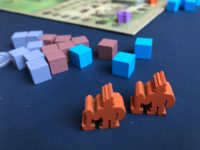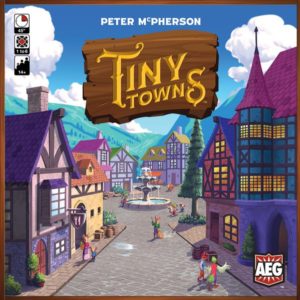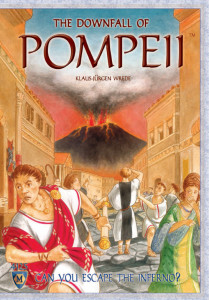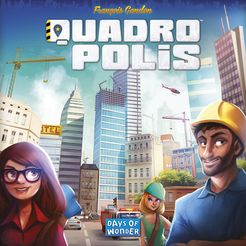- Learning time
- 20 minutes
- First play time
- 60 minutes
Little Town
Designed by: Aya Taguchi,Shun Taguchi
In Little Town the players are collaborating on the building of the said town…. only they’re just as likely to get in each other’s way as assist.
The reversible board is placed on the table, and a number of building tiles are placed on the available spaces at the bottom. For your first game, use the buildings with the little Robin on them, and stack the five wheat field tiles (these are considered a ‘building’ as well). Players take a number of wooden buildings and workers in their own colour, three coins, and you’re ready to go.
Over four rounds, players will place their workers on the board, until all workers are placed, and then the round is over – and each worker must be fed. There’s two places to send your worker – to collect resources, or build buildings. Collecting resources is simple: place your worker on any empty spot on the board, and it will gather from every one of the eight spaces around it: fish from water, wheat from fields, wood from trees and stone from cliffs. The resources are represented by blue/yellow/brown/grey cubes: simply pick up a cube for each resource.
Building is almost as simple: place a worker in the workshop (bottom left of the board) and spend the resources required to pay for one of the building tiles: having done so, you place it in any available spot on the board, putting one of your wooden buildings on it to denote ownership, and score points for doing so. The space taken up by the building is no longer free for workers to occupy, but now the building itself is available to use when a worker is placed adjacent to it: each building either provides resources or a way to turn resources into points. This is free for the owner, but at the cost of a coin to anyone else. So the town itself grows over time, and placement of buildings and workers are both key to success.
Also key is providing food for your famished workers – every worker needs either a fish or a wheat at the end of each round, and any worker you cannot feed costs you minus three points. After workers are fed and returned to their owners, a new round begins – and after the fourth round, the player with the most points wins.
The guru's verdict
-
Take That!
Take That!
It's one of those games that can be played with a gentle, let's-build-together-and-compare-points type of approach - or actually be quite a dastardly affair, with workers and buildings blocking prime spots, buildings claimed before someone else gets them, workers forced to go hungry and so on. Surprisingly nasty, in fact, considering its cheery appearance.
-
Fidget Factor!
Fidget Factor!
Low - even with four players you shouldn't be sat for an age between turns. And you need to be aware of what the other players are doing anyway.
-
Brain Burn!
Brain Burn!
Low overhead on rules, erring towards moderate on implementation. Likely the winner will have found a way to connect buildings so one produces X and another turns it into points, and they're played a canny game of placement.
-
Again Again!
Again Again!
The basic game of the starter tiles varies depending on strategy. But you can also change up for the 'advanced' tiles to keep the experience fresh.












Sam says
Casting a glance at Little Town doesn't exactly get the blood running: it takes a well-worn game mechanism (placing workers) triggering another (placing tiles) that do a third (gather resources) and mixes in a fourth (feed your workers) before terminating at a fifth (change resources into points). For Joe and I, with our long-standing board-game obsession, it's like a box of déjà vu. But don't discount it lightly - this is a proper game, bristling with interaction. As hinted at in Take That below, you can play the game gently: with two players especially it's possible to sort of get on with your own business, and compare scores at the end. But I think Little Town's best with 3 or 4, when players are getting in each others way, blocking, nabbing, grabbing and causing all manner of conniptions. That's when it comes to life and - as long as you're ok with that type of game experience - brings home the goodies. For one person, anyway.